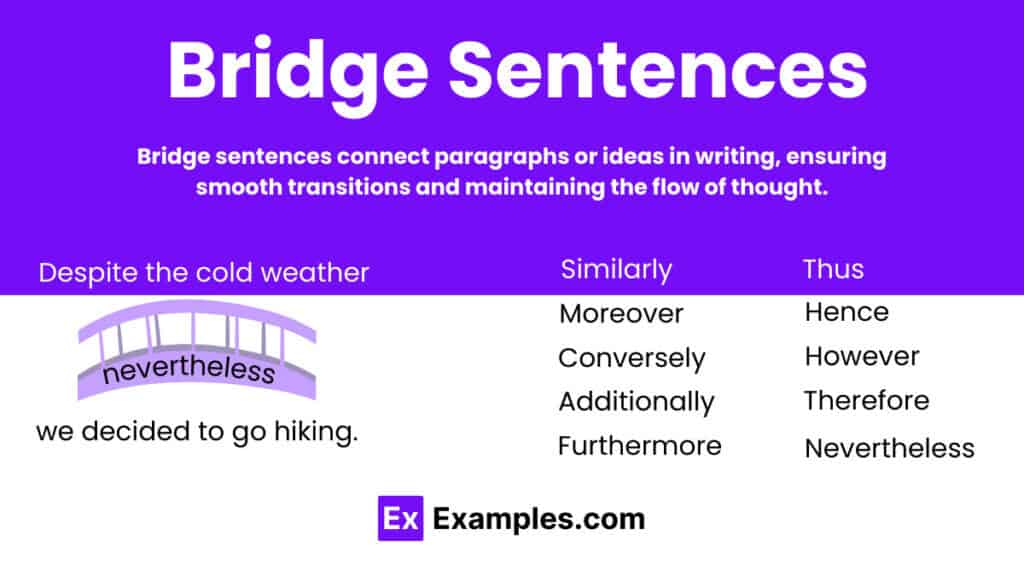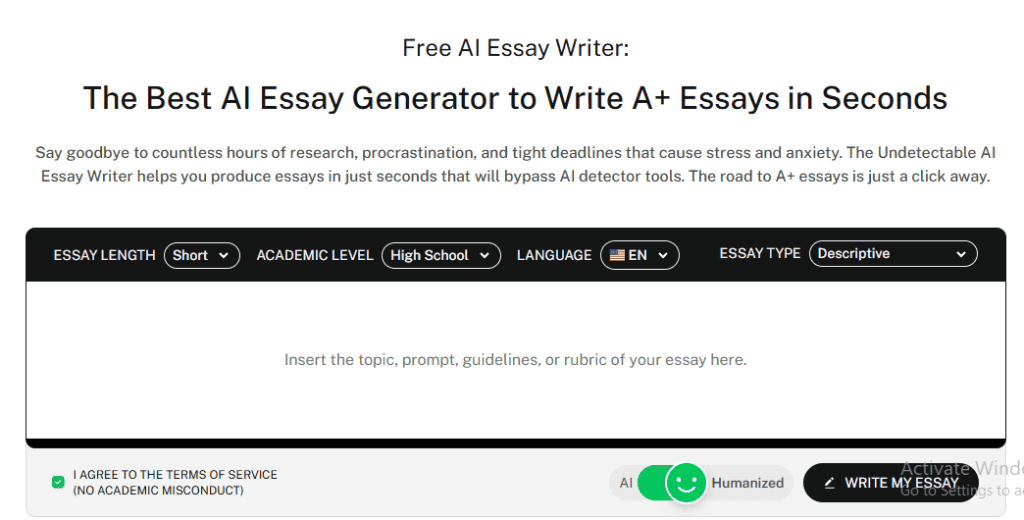Have you ever binge-watched a Netflix series and suddenly realized you were five episodes deep?
Each scene flows so smoothly into the next that you get pulled along like a leaf on a river.
Or think about your favorite albums, where the flow from one track to another is perfect and keeps you in a specific mood for each part of the album.
That’s the power of great transitions.
In an essay, the “bridge” does the same thing.
To avoid breaking the reader’s immersion into your piece, despite offering different arguments, proper bridges transform your writing from disjointed fragments into a cohesive masterpiece.
Experienced writers use bridges instinctively, guiding readers through complex ideas without leaving them stranded between thoughts.
Want to know how? Let’s dive into the nuts and bolts of bridge sentences.
Definition: What Is a Bridge in an Essay?
A bridge in an essay is a sentence or group of sentences that connects two ideas, paragraphs, or sections of writing.
Think of it as the literal bridge it’s named after, spanning the gap between separate islands of thought.
The bridge creates logical connections.


Never Worry About AI Detecting Your Texts Again. Undetectable AI Can Help You:
- Make your AI assisted writing appear human-like.
- Bypass all major AI detection tools with just one click.
- Use AI safely and confidently in school and work.
Especially in persuasive essays, it helps readers follow your argument without getting lost in the mental leap from one idea to another.
Bridge sentences typically appear at the end of one paragraph or the beginning of another.
They often contain transitional language that signals the relationship between ideas. Sometimes, they recap what came before while introducing what comes next.
Unlike simple transitions (words like “however” or “therefore”), a bridge does more work.
It doesn’t just indicate a turn in thought but actually carries the reader across that turn so they understand the connection between ideas.
Purpose of a Bridge Sentence

Bridge sentences serve multiple important functions in your writing.
Offer continuity: The primary purpose of any bridge is continuity. Essays without proper bridges often feel like a series of isolated statements rather than a cohesive argument. Bridges create the thread that ties your ideas together into a seamless whole.
Provide context: Bridges help readers understand why they’re moving from one topic to another. This context is essential for complex arguments where connections might not be immediately obvious.
Emphasize your writing: A good bridge can highlight the relationship between ideas, drawing attention to similarities, contrasts, or cause-and-effect relationships that strengthen your argument.
Help guide the reader: Bridges act as navigational tools for your reader.
They signal, “We’re changing direction now” or “We’re building on what came before.” This guidance prevents readers from feeling disoriented as they move through your essay.
Demonstrate critical thinking: Bridges help to show you haven’t just assembled random facts or opinions but have carefully considered how each point relates to the others.
In fact, discourse analysis (specifically Halliday and Hasan’s work on Cohesion in English) outlines how devices like conjunctions, lexical ties, and references play a central role in maintaining textual unity.
Their framework is often used to assess the clarity of academic writing, showing that what appears to be “just a sentence” can determine how coherent or persuasive a text feels to a reader.
Where Does the Bridge Go in an Essay?
Bridges can appear in several locations throughout an essay, and placing them strategically will help you structure your writing more effectively.
The most common placement is at the end of your introduction paragraph.
This crucial bridge connects your introduction (with its thesis statement) to your first body paragraph.
Without this connection, readers may feel a jarring transition between your general introduction and the specific arguments that follow.
Bridges also appear between body paragraphs.
These inter-paragraph bridges connect your separate supporting arguments, showing how each point builds toward your overall thesis.
They’re especially important when shifting between contrasting ideas or moving from one major section of your argument to another.
Within paragraphs, mini-bridges connect individual sentences or ideas.
These intra-paragraph bridges ensure smooth flow even at the micro level of your writing.
A final bridge often appears at the beginning of your conclusion, connecting your body paragraphs back to your thesis statement.
This bridge reminds readers of the journey they’ve taken through your argument before you present your final thoughts.
The exact placement can vary depending on the essay type, your writing style, and the complexity of your argument.
Interestingly, studies on how writing is taught show that students often struggle with transitional phrasing when trying to maintain clarity under restrictive essay word count limits.
The key is to identify places where readers might struggle to see connections between ideas and then build bridges at those junctures.
Example of a Bridge in an Essay
Let’s look at a concrete example of how bridge sentences function in context. Consider this excerpt from an essay about climate change policy:
The economic arguments against immediate climate action fail to account for long-term costs. Critics focus on short-term expenses of transitioning to renewable energy, citing potential job losses in fossil fuel industries and increased energy prices. These economic concerns, though valid in the immediate term, represent a limited perspective when considering the full timeline of climate impacts.
Looking beyond immediate economic impacts reveals the true cost of inaction. Scientific models predict rising sea levels will damage coastal infrastructure worth billions, while agricultural disruptions threaten food security worldwide. These long-term economic consequences far outweigh the short-term costs of preventative measures, suggesting that immediate action is not only environmentally necessary but economically prudent as well.
In this example, the bridge sentence (bolded) connects the paragraph about economic arguments against climate action with the paragraph about long-term economic consequences.
The bridge acknowledges the previous point while pivoting to the contrasting perspective in the next paragraph.
This bridge succeeds because it:
- Signals a shift in perspective (from short-term to long-term thinking)
- Creates continuity by maintaining focus on economic aspects
- Prepares readers for the upcoming argument about long-term costs
- Establishes a logical relationship between the paragraphs
Without this bridge, the transition between paragraphs would feel abrupt and potentially confusing.
What Makes a Strong Bridge Sentence?
Strong bridge sentences share certain characteristics that make them effective at connecting ideas.
Clarity is paramount. A good bridge clearly establishes the relationship between what came before and what comes next.
Avoid vague language that might confuse readers about how ideas relate to each other.
Relevance matters too. Your bridge should connect directly to both the preceding and following content.
It shouldn’t introduce entirely new ideas or tangents that distract from your main argument.
Strong bridges often employ transitional language appropriate to the relationship they’re establishing. Words like “similarly,” “in contrast,” “consequently,” or “furthermore” signal specific types of connections between ideas.
Balance is another key element. A good bridge acknowledges what came before while pointing forward to what’s coming next.
It shouldn’t simply repeat your previous point or prematurely introduce your next point in full detail.
Perhaps most importantly, strong bridges feel natural.
They don’t draw attention to themselves as mechanical devices but integrate seamlessly into your writing, making connections feel intuitive and logical.
In fact, genre-focused academic writing research, particularly Christian M.I.M. Matthiessen’s rhetorical structure theory, shows how transitional elements influence reader interpretation and textual cohesion.
His functional linguistics framework shows that well-placed transitions are not decorative—they guide logic and rhetorical flow, especially in dense informational writing.
Weak bridges, by contrast, often suffer from being too abrupt, too tangential, or too repetitive.
They either fail to establish clear connections or do so in ways that interrupt rather than enhance the flow of your writing.
This is especially noticeable in expository essays, where the lack of strong transitions can turn a logical explanation into a fragmented reading experience.
Tips for Writing Bridge Sentences

Crafting effective bridges takes practice, but these techniques will help you strengthen the connections in your essay:
1. Start by identifying the relationship between your ideas. Are you comparing similar concepts? Contrasting opposing viewpoints? Building a sequence of causes and effects? Understanding this relationship helps you choose the appropriate language for your bridge.
2. Use transitional words and phrases strategically. Different transitions serve different purposes:
- For addition: “furthermore,” “moreover,” “in addition”
- For contrast: “however,” “nevertheless,” “conversely”
- For cause/effect: “consequently,” “as a result,” “therefore”
- For sequence: “first,” “next,” “finally”
3. Look both backward and forward when writing your bridge. Effective bridges often reference a key term or concept from the previous paragraph before introducing the focus of the upcoming paragraph.
4. Vary your bridge techniques. Sometimes, a question makes an effective bridge. Other times, a brief summary works better. Occasionally, a metaphor or analogy can connect ideas memorably.
5. Use AI essay writing tools. If you’re struggling with a particular transition, Undetectable AI’s AI Chat can suggest various approaches to connecting your ideas. It’s designed to generate humanized responses that bypass AI detection tools, and its productivity suite includes brainstorming support, text generation, and even tutoring.
The AI Chat tool can answer writing-specific prompts or compare bridge techniques across essay types—all in a conversational tone that feels authentic.
This aligns with Undetectable’s mission: helping users generate content that balances automation with credibility, even in academic or professional contexts.

If you’re working with AI-generated content and want it to read naturally, try using the AI Humanizer as a final step.
It refines tone, enhances readability, and ensures your bridges and transitions feel genuinely human—not mechanical—making your essay smooth and engaging from start to finish.
Meanwhile, the Essay Writer tool is built to help users create full-length essays with natural-sounding transitions.
All generated content is crafted to feel human-written while maintaining clarity, structure, and flow.

6. Read your essay aloud to test your bridges. If you stumble or feel a disconnect when moving between paragraphs, your bridge might need strengthening.
7. Study bridge sentences in well-written essays and scholarly articles. Research from educational linguistics looks at how transitions influence reader engagement in academic writing by aligning text structure with social purpose.
Make sure to check out our AI Detector and Humanizer conveniently in the widget below!
FAQs About Bridges in Essays
Is a bridge sentence only in the introduction?
No. Bridge sentences appear throughout an essay—between the intro and body, between body paragraphs, within paragraphs, and even in the conclusion.
They’re the glue that keeps your ideas connected.
Can a bridge be more than one sentence?
Yes. Some bridges are a single sentence, but complex ideas may need two or three.
The goal is clarity—just avoid making the bridge so long it becomes its own paragraph.
Is a bridge the same as a transition sentence?
Not quite. Transitions signal a shift, and bridges do the heavy lifting by connecting the actual content.
Think of transitions as signposts and bridges as the road that gets you there.
Do all essays need bridge sentences?
Most do. Academic and professional writing especially benefits from clear bridges.
Without them, even good ideas can feel disjointed. While short or creative pieces might use them less, bridges almost always improve flow and coherence.
Tying It All Together
Bridge sentences transform your essay from a collection of separate ideas into a cohesive, flowing argument.
They guide your readers through your thinking, helping them understand how each point connects to your overall thesis.
Without these crucial elements, even the strongest ideas can lose impact through poor organization.
As you practice writing bridge sentences, you’ll develop an intuitive sense of when and how to connect your ideas.
This skill extends beyond academic essays into professional writing, creative work, and even everyday communication.
The ability to establish clear relationships between concepts is fundamental to effective writing of all kinds.
Need help making those connections smoother? Undetectable AI’s Essay Writer and AI Chat can help you build bridges that flow naturally and pass as entirely human-written.
Whether you’re working on a tight deadline or refining your tone, the tools are designed to elevate clarity, structure, and voice, without compromising originality.
